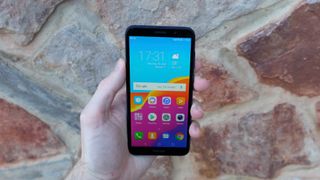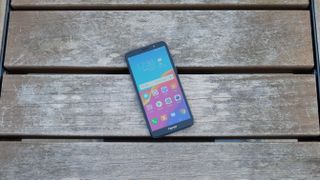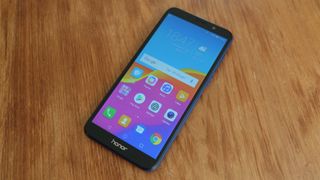TechRadar Verdict
With solid build quality and a decent screen, the Honor 7S appears to be a bargain. However, poor performance and the lack of a fingerprint scanner reveal a budget phone that makes too many compromises.
Pros
- +
Very low price
- +
Big, bright display
- +
Camera needs the right conditions
Cons
- -
Awful performance
- -
Ugly EMUI
- -
No fingerprint scanner
Why you can trust TechRadar
Update: after Google suspended Huawei's future access to Android Play Store and security updates, there are serious question marks over the future of Huawei and Honor phones.
While Google and Huawei have promised to support phones currently on the market, it's not clear how long they'll receive Android updates or access to the Google Play Store, which would severely curtail their usefulness compared to the competition.
It seems Honor won’t stop until it has a phone representing every incremental price point up to £400 (around $550/AU$720). The Honor 7S has arrived to anchor a range that includes the Honor 7A, the Honor 7X and the Honor 7C.
Entering the market at just £99 (around $130 / AU$180, but not currently available in the US or Australia), the Honor 7S looks to strip things back even further than the £140 / $185 / AU$250 Honor 7A did.
Given that we criticized that handset for cutting a little too deep in its bid for bargain status, it’s interesting to see how much further the Huawei sub-brand can go.
Of course, the Honor 7S isn’t alone in attempting to create a usable smartphone for so little money. Just recently we’ve seen Vodafone make another creditable effort to do something along these lines with the Vodafone Smart N9 - and very nearly getting away with it.
Sadly, the Honor 7S doesn’t get anywhere near as close to hitting its target. Just like with the 7A, we have to question whether cheap equates with good value here.

An audio-visual extravaganza?
- Doesn't live up to claims of clearer calls
- Has a trendy 18:9 display
Weight: 142g
Dimensions: 146.5 x 70.9 x 8.3mm
OS: Android 8.1
Screen size: 5.45-inch
Resolution: 720 x 1440
CPU: MediaTek MT6739
RAM: 2GB
Storage: 16GB + microSD
Battery: 3,020mAh
Rear camera: 13MP
Front camera: 5MP
That tiny price tag might be the main story, but Honor clearly wants the Honor 7S hardware to make itself heard. Quite literally, in fact.
The Honor 7S web page leads with the heading, 'View more, hear clearer'. The latter portion of that quote is a reference to the phone’s literally named Larger Receiver Volume feature.
Apparently, the Honor 7S will provide clearer listening in noisy environments, and will adjust the volume of the call according to your environment. In practice, we couldn’t tell much of a difference to any other cheap phone.
Calls seemed plenty loud enough, yes, but not noticeably different from other handsets at and around this price. Indeed, at the other end of our calls, we had complaints that the call quality was a little off, and that it sounded like we had put them on loudspeaker.
This is far from a scientific test, of course, and we can’t rule out network issues here. But the main point to note is that Honor’s claims of boosted audio don’t hold an awful lot of practical weight.
As for the 'view more' side of the headline, this is a reference to the Honor 7S’s FullView Display. We’ve seen plenty of front-filling 18:9 aspect ratio displays further up the smartphone food chain, but they're also starting to seep into the lower end of the market.
The rest of the Honor 7 range has a similar feature, but it’s not exactly unique around the £100/$130 mark either. The aforementioned Vodafone Smart N9 also packs an expansive 18:9 display.
Still, there remain plenty of phones that launch with chunky borders, and while the Honor 7S is hardly bezel-less, its roughly 73% screen-to-body ratio is nothing to be sniffed at.

Design
- Solid all-plastic build
- Lack of fingerprint sensor is a major omission
Honor has stuck with a similar design approach to the more expensive Honor 7A for the Honor 7S. That means a fairly bland slab of plastic with a deep metallic shade of blue chosen for the back and (thankfully non-reflective) sides. It also comes in black or gold.
The front of the phone is an all-glass affair, with a black border surrounding the display. As already mentioned, it’s not what you’d call a bezel-less design, but the phone’s forehead and chin aren’t too prominent.
This certainly isn’t a handsome phone, but nor is it garish or tacky looking. That’s about all you can ask for in such a cheap smartphone. The surprisingly sharp Vodafone Smart N9 is the exception that proves the rule here.

More important than the looks of such a phone is how it feels and handles, and on that front we have no qualms whatsoever. Honor knows how to build solid hardware on a budget by now, and the 7S is largely free of creak and flex.
There’s a nice weight of 142g to the phone, which stops it from feeling too fly-away or disposable. Despite this, it’s perfectly easy to hold in one hand, thanks to dimensions of 146.5 x 70.9mm and a thickness of 8.3mm, which is not far off the iPhone X.
The side buttons are clicky and easy enough to locate, though we would have liked some kind of texture to the power button to help differentiate it from the volume rocker.
There are two external design omissions that let you know in no uncertain terms that this is an ultra-cheap smartphone, and one of those is potentially fatal here in 2018. There’s no fingerprint scanner.

We’ve surely gotten to the point now where biometric access is expected, even at the lower end of the market. Both the aging Wileyfox Swift 2 and the new Vodafone Smart N9 have one, to name just two similarly priced examples.
Maybe we burn through too many phones, but we found that switching to the Honor 7S required a major rewiring of the brain. Even after spending some time with the phone, we often noticed a slight pause in our mental processing when we picked it up and fished around for an unlock mechanism.
We’re used to being able to unlock our phones securely with a touch or a look now, and having that taken away feels like a major step backwards. That’s not even to mention the implications for mobile payments. Coupled with a lack of NFC, Google Pay is a no-no.
The other external omission here is USB-C. The modern reversible connection standard has been bypassed in favor of the older micro USB standard, though this is still pretty common in cheaper phones.
Screen
- Bright 5.45-inch FullView display
- 720 x 1440 resolution
The Honor 7S is another budget phone to receive the FullView display treatment. This means that it has been stretched out to an 18:9 aspect ratio rather than the more traditional 16:9.
We’ll discuss what this means in media terms a little later (spoiler alert: not as much as you’d think), but the true purpose of these longer screens is to improve the screen-to-body ratio of the phone.
In the old days, a 5.5-inch phone would be a pocket-filling monstrosity. Here in the 18:9 era with taller and slimmer screens, they’re far more wieldy, and the Honor 7S is no different.
The screen itself is a 5.45-inch LCD with a 720 x 1440 resolution. That equates to 720p, with the extra pixels accounting for the extra height.

No, it’s not the ideal resolution for a screen of this size. We would have much preferred 1080p. But in a phone of this price, it’s more or less to be expected.
Both the aforementioned Wileyfox Swift 2 and the Smart N9 go with 720p, so it’s clearly a bit of a red line if you’re seeking to build a balanced £100/$130 smartphone.
It’s a perfectly acceptable compromise too, as it turns out. The Honor 7S display obviously isn’t the best screen we’ve ever seen, but it’s reasonably balanced, not too washed out, and it gets nice and bright.
The screen is plenty sharp enough for practical day to day tasks too. Web browsing - arguably the best all-round test for such things - is perfectly pleasant, though you do notice the relative lack of pixels in thumbnail images and smaller text.

